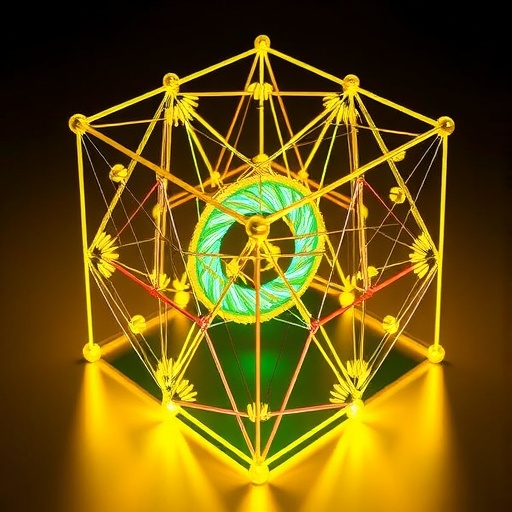In a landmark achievement poised to redefine our understanding of quantum materials, an international collaboration of physicists has reported the first direct experimental measurement of the quantum metric tensor in a solid-state system. This breakthrough provides a novel window into the geometric properties of quantum states in crystalline materials, offering profound implications for both fundamental physics and future quantum technologies. The research, spearheaded by Professor Keun Su Kim of Yonsei University in South Korea, was published on June 5, 2025, in the prestigious journal Science.
Quantum distance, an abstract yet critically important concept in quantum mechanics, quantifies the similarity between two quantum states. Contrary to classical distance, it captures how “close” or “far” quantum wavefunctions are in their complex, high-dimensional configuration spaces. A quantum distance of one signifies identical states, whereas zero indicates states that are orthogonal — fundamentally distinct. Although conceptualized decades ago, the direct measurement of this quantum property in real materials remained beyond experimental reach until now.
Central to this advance is the quantum metric tensor, a mathematical construct defined in terms of infinitesimal quantum distances between nearby states. This tensor encapsulates the geometry of quantum state spaces, influencing how electrons behave and respond within a crystal lattice. It has increasingly been recognized as a cornerstone for interpreting exotic phenomena in condensed matter physics, such as topological phases, superconductivity, and anomalous transport effects. Yet, until this study, its experimental determination in solids was largely speculative.
The interdisciplinary team combined theoretical insights with cutting-edge experimental techniques to overcome this challenge. Theoretical physicists led by Professor Bohm-Jung Yang at Seoul National University identified black phosphorus — a layered semiconductor — as an ideal platform. This material’s structurally simple yet electronically rich properties allow a faithful mapping of quantum geometric signatures onto observable quantities. Such a strategic material choice was vital for enabling direct quantum metric measurements in a solid.
On the experimental front, Professor Kim’s group employed advanced angle-resolved photoemission spectroscopy (ARPES), coupled with polarization control and synchrotron radiation at the Advanced Light Source in the USA. By analyzing the momentum-resolved pseudospin textures of valence electrons in black phosphorus, they were able to reconstruct the quantum metric tensor with unprecedented precision. This intricate approach translates subtle variations in measured electron states into quantitative geometric data, bridging theoretical predictions and laboratory reality.
The implications of accurately measuring the quantum distance extend well beyond academic curiosity. The quantum metric tensor underpins the fundamental electronic characteristics of materials, influencing how electrons traverse energy bands, how currents respond to external fields, and how collective quantum phenomena emerge. Particularly, understanding quantum geometry is pivotal for engineering materials that host robust superconductivity at higher temperatures and for devising fault-tolerant quantum computing architectures, where geometric robustness mitigates errors in quantum information processing.
Moreover, the experimental protocols established by this study provide a blueprint for future explorations across a broad class of crystalline systems. By unlocking access to the quantum metric tensor, researchers can now investigate how quantum geometric effects interplay with disorder, interactions, and external perturbations, potentially uncovering new physical regimes and guiding the design of materials with tailor-made quantum functionalities.
Professor Kim emphasizes the fundamental and technological relevance of this work, stating, “Measuring the quantum distance is not only key to unraveling anomalous quantum phenomena in solids but also a crucial step toward advancing quantum science and enabling next-generation technologies.” This duality of fundamental insight and applied potential situates the research at the forefront of both condensed matter physics and quantum engineering.
This pioneering experiment leverages synchrotron-based ARPES, which provides high-resolution momentum space snapshots of electron states. The researchers exploited the polarization dependence of photoemitted electrons to extract the pseudospin orientation — a quantum mechanical property analogous to spin but linked to lattice degrees of freedom — that encodes geometric information. The resultant data enabled a full reconstruction of the quantum metric tensor components, a feat previous measurement attempts could not achieve.
The black phosphorus system itself is receiving renewed attention following this work. Known for its anisotropic electronic properties and direct bandgap, it now serves as a model system elucidating how quantum geometry manifests in layered materials. Insights gained here may inform the exploration of similar van der Waals materials, which are increasingly prominent in quantum materials research due to their tunability and novel phases.
From a broader perspective, this research highlights the importance of integrating theoretical predictions with sophisticated experimental methodologies to probe elusive quantum features. It demonstrates that long-standing theoretical constructs, once considered mere abstractions, can be translated into measurable quantities, thereby enriching our empirical understanding of the quantum world.
Ultimately, the successful measurement of the quantum metric tensor heralds a new era in solid-state physics, wherein quantum geometry becomes a tangible and exploitable characteristic. This advance promises to accelerate the development of devices that rely on subtle quantum mechanical effects — from ultra-efficient semiconductors and high-temperature superconductors to robust quantum information processors capable of overcoming decoherence challenges inherent in quantum computing.
As quantum technologies continue their rapid evolution, the ability to quantify and manipulate quantum distance within materials will be indispensable. This work paves the way for future research that could unlock transformative applications, ushering in unprecedented capabilities in information processing, sensing, and energy conversion. The quantum metric tensor, once an elusive theoretical quantity, now stands as a measurable and practical feature at the heart of quantum materials science.
Subject of Research: Not applicable
Article Title: Direct measurement of the quantum metric tensor in solids
News Publication Date: 5-Jun-2025
Web References:
https://www.science.org/doi/10.1126/science.ado6049
References:
DOI: 10.1126/science.ado6049
Image Credits:
Keun Su Kim from Yonsei University
Keywords
Condensed matter physics, Quantum mechanics, Solid state physics, Materials science, Quantum computing, Superconductors, Semiconductors, Synchrotron radiation, Spectroscopy, Quantum states




